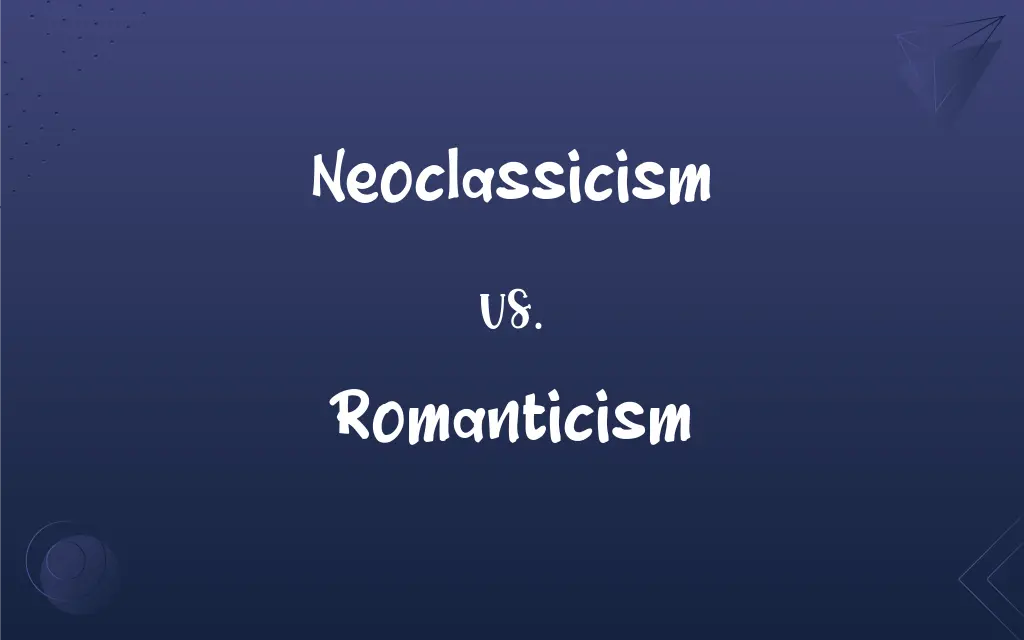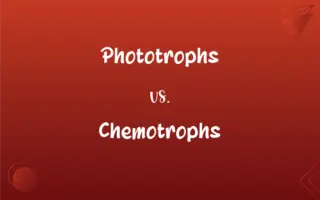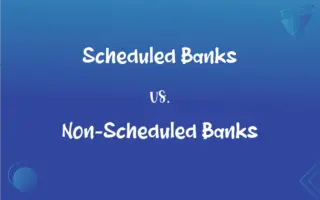Neoclassicism vs. Romanticism: What's the Difference?
Edited by Janet White || By Harlon Moss || Updated on October 2, 2023
Neoclassicism emphasizes logic, proportion, and restrained emotion, while Romanticism values feeling, intuition, and individualism.

Key Differences
Neoclassicism cherishes the stability, structured forms, and objective rationale in art and literature, contrasting with Romanticism which embraces emotive expression, creative spontaneity, and subjectivity as its core virtues, thereby allowing artists to explore unrestrained feelings and inspirations.
While neoclassicism draws rich inspiration from the classical age, glorifying its rationality, symmetry, and order, Romanticism seeks to break free from classical constraints, embodying a pursuit of individualism, imagination, and the unexplored depths of human emotions and nature.
The intellectual rigidity and disciplined forms seen in neoclassicism, celebrating logical coherence and aesthetic balance, markedly deviate from Romanticism’s dedication to expressive freedom, emotional depth, and a potent emphasis on the spiritual and mystical aspects of life.
Neoclassicism leans towards a collective societal focus, often placing characters and narratives in socially relevant contexts, whereas Romanticism leans into the personal and introspective, exploring characters’ inner landscapes and personal journeys, often in defiance of societal norms.
The adherence of neoclassicism to established artistic norms, regulated structures, and societal relevancy contrasts with the turbulent, free-form explorative spirit of Romanticism, which seeks to delve into the uncharted territories of human experience, emotion, and introspection.
ADVERTISEMENT
Comparison Chart
Emotional Expression
Restrained and controlled
Expressive and free
Structural Approach
Structured and formal
Free-form and spontaneous
Philosophical Focus
Rationality and society
Emotion and the individual
Typical Themes
Honor, society, and reason
Nature, passion, and the supernatural
Neoclassicism and Romanticism Definitions
Neoclassicism
An artistic movement focused on classical forms.
Neoclassicism often borrows themes from ancient Greek and Roman traditions.
ADVERTISEMENT
Romanticism
Celebrates the unconventional and the pursuit of personal truth.
Romanticism endorsed the exploration of unconventional narratives and personal truths.
Neoclassicism
Maintains a respect for traditional forms and structures.
Neoclassicism retained the structured poetics of classical literature.
Romanticism
Encourages explorative and spontaneous creative processes.
Artists in the Romanticism period often pursued spontaneous and intuitive creative methodologies.
Neoclassicism
Adheres closely to societal and moral themes.
Neoclassicism often depicted stories centered around societal norms and moral ethics.
Romanticism
Places a high value on individualism and personal expression.
Romanticism fostered narratives that prioritized individual journeys and experiences.
Neoclassicism
Values reason, logic, and structure in art and literature.
Neoclassicism upheld the virtues of logical narrative structures in storytelling.
Romanticism
Often draws inspiration from nature and the supernatural.
Romanticism found profound aesthetic and thematic inspirations in natural and supernatural elements.
Neoclassicism
Predominantly restrained in emotional expression.
Art in the neoclassicism era portrayed measured and controlled emotions.
Romanticism
An artistic and literary movement valuing emotional expressiveness.
Romanticism allowed poets to explore and express varied emotions freely.
Romanticism
Often Romanticism An artistic and intellectual movement originating in Europe in the late 1700s and characterized by a heightened interest in nature, emphasis on the individual's expression of emotion and imagination, departure from the attitudes and forms of classicism, and rebellion against established social rules and conventions.
Romanticism
Romantic quality or spirit in thought, expression, or action.
Romanticism
A romantic quality, spirit or action.
Romanticism
A fondness for romantic characteristics or peculiarities; specifically, in modern literature, an aiming at romantic effects; - applied to the productions of a school of writers who sought to revive certain medi val forms and methods in opposition to the so-called classical style.
He [Lessing] may be said to have begun the revolt from pseudo-classicism in poetry, and to have been thus unconsciously the founder of romanticism.
Romanticism
Impractical romantic ideals and attitudes
Romanticism
A movement in literature and art during the late 18th and early 19th centuries that celebrated nature rather than civilization;
Romanticism valued imagination and emotion over rationality
Romanticism
An exciting and mysterious quality (as of a heroic time or adventure)
FAQs
What is Neoclassicism?
Neoclassicism is an art and cultural movement that sought to revive the styles and values of classical antiquity, emphasizing order, symmetry, and simplicity.
When did Neoclassicism emerge?
It emerged in the mid-18th century, particularly in France, as a reaction to the Baroque and Rococo styles.
What are the key characteristics of Neoclassical art?
Key characteristics include symmetry, simplicity, and an emphasis on heroic or moral themes.
Who are some notable figures of Neoclassicism?
Jacques-Louis David, Jean-Auguste-Dominique Ingres, and Johann Joachim Winckelmann are notable figures in Neoclassicism.
How is Neoclassicism reflected in literature?
Neoclassical literature emphasizes reason, logic, and strict forms, often exploring moral and ethical themes.
Which art forms did Neoclassicism influence?
Neoclassicism influenced various art forms, including painting, sculpture, literature, and architecture.
What inspired Neoclassicism?
The discovery of ancient artifacts and sites, like Pompeii, and a fascination with the ancient civilizations of Greece and Rome, inspired Neoclassicism.
How did Neoclassicism impact architecture?
Neoclassical architecture featured grandiose columns, domes, and clean lines, often modeled after Greek and Roman structures.
How did Romanticism manifest in art?
Romantic art often showcased dynamic, emotional scenes and embraced dramatic color and contrast.
What is Romanticism?
Romanticism is a cultural and artistic movement emphasizing emotion, imagination, and individualism, originating in the late 18th century.
Was Neoclassicism confined to Europe?
While it originated in Europe, Neoclassicism influenced art and architecture worldwide.
Who are notable figures in Romanticism?
Notable figures include poets like William Wordsworth and painters like Francisco Goya.
What is the "sublime" in Romanticism?
The "sublime" refers to experiences of awe and terror, often invoked by nature’s grandeur or other overwhelming phenomena.
Did Romanticism influence music?
Yes, Romanticism significantly impacted music, with composers like Ludwig van Beethoven and Franz Schubert emphasizing emotion and creating innovative compositions.
What values did Neoclassicism uphold?
Neoclassicism upheld values like order, rationality, and adherence to traditional structures and forms.
Which countries were influential in the Romantic movement?
Germany, England, and France were particularly influential in the development of Romanticism.
Was Romanticism only an artistic movement?
While deeply rooted in the arts, Romanticism also permeated philosophy and political thought, valuing individual and national freedom.
How did Romanticism and Neoclassicism differ?
Romanticism emphasized emotion and individualism, while Neoclassicism valued order, reason, and classical forms.
How did Romanticism influence literature?
Romantic literature emphasized emotion, celebrated the individual, and often explored themes of nature and the sublime.
What are the core values of Romanticism?
Core values include a focus on emotion, nature, and a fascination with the exotic and mystical.
About Author
Written by
Harlon MossHarlon is a seasoned quality moderator and accomplished content writer for Difference Wiki. An alumnus of the prestigious University of California, he earned his degree in Computer Science. Leveraging his academic background, Harlon brings a meticulous and informed perspective to his work, ensuring content accuracy and excellence.
Edited by
Janet WhiteJanet White has been an esteemed writer and blogger for Difference Wiki. Holding a Master's degree in Science and Medical Journalism from the prestigious Boston University, she has consistently demonstrated her expertise and passion for her field. When she's not immersed in her work, Janet relishes her time exercising, delving into a good book, and cherishing moments with friends and family.































































